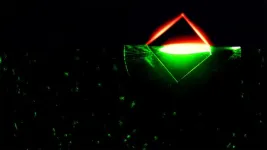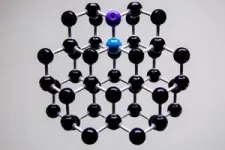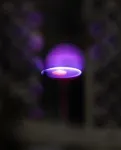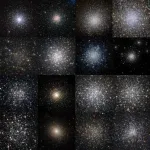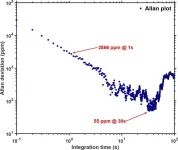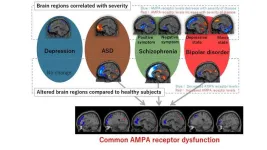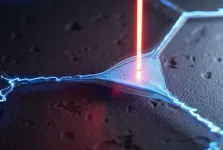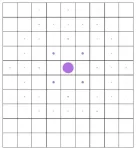(Press-News.org) Researchers are developing new ideas about the best ways to make lab-grown diamonds while minimizing other forms of carbon, such as soot. These diamonds aren’t destined for rings and necklaces, though. These are the kinds that are needed for the computers, optics and sensors of the future.
One new study, conducted by researchers at the U.S. Department of Energy’s (DOE) Princeton Plasma Physics Laboratory (PPPL) and Princeton University, investigated ways to reliably grow diamond at lower temperatures than those currently used. Diamond has properties that make it attractive to the semiconductor industry. With its particular crystal lattice structure, diamond can withstand high electrical voltages. It’s also very good at dissipating heat.
“This work is part of PPPL’s broader efforts to advance microelectronics by providing critical research into the materials and processes that could prove essential to ensuring a continued competitive advantage for the United States in this high-tech field,” said PPPL Principal Research Physicist Igor Kaganovich, a co-author on the paper.
Growing diamond in a laboratory typically involves high heat beyond what computer chips can handle; therefore, scientists have long been searching for ways to reduce the heat without sacrificing diamond quality.
“If we want to implement diamond into silicon-based manufacturing, then we need to find a method of lower-temperature diamond growth,” said Yuri Barsukov, a computational research associate at PPPL who was the lead author of the study. “This could open a door for the silicon microelectronics industry.”
A close-up of one of the quantum diamond reactors at PPPL’s Quantum Diamond Lab. The glow inside the device comes from the plasma used to make quantum diamond using a process known as chemical vapor deposition. (Photo credit: Michael Livingston / PPPL Communications Department)
Finding the critical temperature
Past experiments into a process for making diamond, known as plasma-enhanced chemical vapor deposition, showed that acetylene can contribute to diamond growth. However, acetylene was also known to contribute to the growth of soot, which can grow on top of diamond and inhibits performance for optics, sensors and chips. The factors that determined whether the acetylene became diamond or soot were unclear.
“Now we have an answer,” Barsukov said. “Like water to ice, there is a critical temperature for the transition of one phase to another. Above this critical temperature, acetylene contributes mostly to diamond growth. Below this critical temperature, it contributes mostly to soot growth.”
According to the study, which was published in the journal Diamond & Related Materials, the critical temperature depends on several factors, including the concentration of acetylene and atomic hydrogen near the surface of the diamond.
“Hydrogen atoms don’t fuel diamond growth directly, but hydrogen dissociation, or breakdown, is crucial for transforming methane into acetylene and transporting atomic hydrogen to the diamond growth surface. These are both important for diamond growth,” said Princeton University Research Scholar Alexander Khrabry, an author of the paper. With more hydrogen near the surface, more diamond can form, even at lower temperatures.
Protecting quantum diamond
Perfecting the process for growing quality diamond at lower temperatures is just one piece of the puzzle to reliably making diamond for electronics. Some applications require a more complicated form of diamond in which some carbon atoms are removed, and a neighboring atom is replaced with nitrogen. This creates what scientists call nitrogen-vacancy centers or NV centers.
A separate study related to NV centers was published in the journal Advanced Materials Interfaces by researchers from PPPL, Princeton University and the Royal Melbourne Institute of Technology. This study looked at ways to protect the surface of this special material, which is known as quantum diamond, while keeping the NV centers intact.
This model of quantum diamond shows the carbon atoms in black. The purple ball represents the nitrogen, while the blue ball represents an empty spot in the lattice. Together, the nitrogen and empty space create the nitrogen-vacancy (NV) center used in quantum applications. (Image credit: Michael Livingston / PPPL Communications Department)
“The electrons in this material don’t behave according to the laws of classical physics as heavier particles do. Instead, like all electrons, they behave according to the laws of quantum physics,” said Alastair Stacey, a managing principal research physicist and head of quantum materials and devices at PPPL who was a co-author on the study. One way researchers hope to harness these quantum behaviors is by making special bits called qubits. “The advantage of qubits is that they can hold much more information than regular bits can,” said Stacey. “This means that they can also give us much more information about their environment, making them extremely valuable as sensors, for example.”
Adding an even layer of hydrogen atoms
Attaching hydrogen to the diamond surface has implications both for microelectronics and quantum sensors. Hydrogen atoms can interact with diamond surfaces and lead them to conduct electricity, and, at the same time, they are needed as a starting point before attaching other, more complex molecules. The challenge is creating a single layer of hydrogen atoms evenly distributed on the surface of the quantum diamond without changing what lies beneath.
“People have been trying to control diamond surfaces for a very long time,” said Nathalie de Leon, an associate professor of electrical and computer engineering at Princeton University, associated faculty at PPPL and a co-author on the paper. “It’s an interesting fundamental science question because diamond is sort of a weird solid. You have a material that is exactly the same everywhere, and then at the very surface, it has to somehow bond to something else. But diamond is very inert, meaning it doesn’t want to react with things. It’s a very tight lattice, so it’s hard to get things in there. It’s also the hardest material in the world, so it’s very hard to polish and prepare in various ways.”
The study explores more reliable and less damaging techniques for adding that single layer of hydrogen atoms to the surface of the diamond so that it is ideal for certain quantum applications. It’s part of a broader area of research at the Lab on preparing diamond surfaces for quantum computing and sensing. PPPL opened its Quantum Diamond Laboratory in March 2024, making the Lab an ideal partner for such research.
The way atoms bond in diamond makes the material well suited for quantum applications, including quantum computing, secure communications, and highly accurate measurements of temperature and magnetic fields.
“We need to precisely control the chemistry on the surface of the diamond using plasma, but plasma-surface interactions are not very well understood,” said Barsukov, who was also part of the second study. “People usually use a method of trial and error. So, we’re trying to shed light on some of the processes on the surface, just to make the picture a little bit clearer.”
Typically, this hydrogen layer is added by exposing the diamond to a hydrogen plasma under high heat. But, much like silicon in standard computer chips, the NV centers can’t handle this environment.
Creating a recipe book for quantum diamond
The research team sought to find better methods for making hydrogenated quantum diamond with the NV centers intact. “We’re writing a recipe book and characterizing different ways of properly hydrogenating diamond surfaces so that we understand how to do this better for a number of applications,” said Daniel McCloskey, the first author of the paper and a researcher at the School of Physics at the University of Melbourne.
The international research team investigated the traditional approach as well as the following two alternative hydrogenation methods:
Forming gas annealing, which uses a mixture of hydrogen molecules and nitrogen gas (rather than a plasma made only of hydrogen).
Cold plasma termination, which uses a hydrogen plasma but avoids direct heating of the diamond with the plasma.
Both alternative techniques produced hydrogenated diamond that could conduct electricity, but there are key differences and trade-offs. Specifically, the team found that the quality of the hydrogen layer made with forming gas annealing was highly dependent on the temperature used and the purity of the gas mixture. While no oxygen should be present during the experiment, some can leak in, and even that relatively small amount made a big difference.
“You have to get that oxygen off the diamond,” explained McCloskey, and that required temperatures upward of 900°C. McCloskey said developing ways to reduce and eliminate oxygen entering the reaction chamber is another important area of research that needs to be explored, adding that they had to go above and beyond the standard protocols to make it work.
The cold plasma termination method also created a hydrogen layer on the quantum diamond without damaging the NV centers. However, the trade-off is that the hydrogen layer made with cold plasma termination was of lower quality than the traditional heated approach.
Assessing the damage to NV centers
To investigate the impact of the hydrogenation methods on NV centers, the team used a technique called photoluminescence spectroscopy. “This is a way to peek in at a diamond sample that is full of NV centers by exciting them with green light and making them fluoresce,” Stacey explained. Neither of the two new hydrogenation methods affected fluorescence, even when the processes were repeated. However, the traditional heated plasma treatment resulted in an irreversible loss of nearly half of the NV center fluorescence.
“This highlights the trade-off between surface quality and NV properties that will have to be balanced in future applications. For instance, in biomolecular sensing projects, it is absolutely crucial that NVs be preserved close to surfaces,” said McCloskey.
Further research is required to perfect the new methods for reliably producing high-quality hydrogenated diamond surfaces with ideal NV centers. There are also many other avenues for PPPL and its collaborators to explore. While an even coating of hydrogen atoms might be the end goal for some applications, for others, it may just be the first step of many to create a custom surface involving other elements.
The first study, “Quantum Chemistry Model of Surface Reactions and Kinetic Model of Diamond Growth: Effects of CH3 Radicals and C2H2 Molecules at Low-temperatures CVD” was supported by the DOE under the “microelectronics co-design” research DOE national laboratory program and used computing resources on the Princeton University Adroit cluster and Stellar cluster. For the second study, “Methods for Color Center Preserving Hydrogen-Termination of Diamond,” the authors acknowledge support from the Australian Research Council (ARC) through grants DP200103712, CE170100012 and FL130100119. Support was also provided by the University of Melbourne proof-of-concept grant and the ARC Centre of Excellence in Quantum Biotechnology through project number CE230100021. The U.S. National Defense Science and Engineering Graduate Fellowship also provided additional support. In situ annealing and spectroscopy studies at Princeton were primarily supported by the DOE’s Office of Science and Office of Basic Energy Sciences under award number DESC0018978, and the instrumentation development was supported by the National Science Foundation’s CAREER program grant number DMR1752047. This material is based upon work supported by the DOE’s Office of Science, Office of Fusion Energy Sciences and Office of Basic Energy Sciences under award number LAB 21-2491.
PPPL is mastering the art of using plasma — the fourth state of matter — to solve some of the world’s toughest science and technology challenges. Nestled on Princeton University’s Forrestal Campus in Plainsboro, New Jersey, our research ignites innovation in a range of applications including fusion energy, nanoscale fabrication, quantum materials and devices, and sustainability science. The University manages the Laboratory for the U.S. Department of Energy’s Office of Science, which is the nation’s single largest supporter of basic research in the physical sciences. Feel the heat at https://energy.gov/science and https://www.pppl.gov.
END
Ensuring a bright future for diamond electronics and sensors
Researchers are perfecting processes to grow high-quality diamond material reliably and efficiently
2024-11-05
ELSE PRESS RELEASES FROM THIS DATE:
The American Pediatric Society selects Dr. Maria Trent as the Recipient of the 2025 David G. Nichols Health Equity Award
2024-11-05
The American Pediatric Society (APS) is pleased to announce Maria E. Trent, MD, MPH, as the 2025 David G. Nichols Health Equity Award recipient.
The David G. Nichols Health Equity Award, administered by the APS and endowed by the American Board of Pediatrics (ABP) Foundation, was created to recognize demonstrated excellence in advancing child and adolescent health, well-being, and equity through quality improvement, advocacy, practice, or research. This award recognizes Dr. Trent’s outstanding contributions to advancing child and adolescent health, well-being, and equity and the far-reaching impact of her work. The award will be presented to Dr. Trent ...
The first 3D view of the formation and evolution of globular clusters
2024-11-05
A study published today in Astronomy & Astrophysics marks a significant milestone in our understanding of the formation and dynamical evolution of multiple stellar populations in globular clusters (spherical and very compact stellar agglomerates typically populated by 1–2 million stars). This pioneering study, conducted by a group of researchers from the National Institute for Astrophysics (INAF), the University of Bologna, and Indiana University, is the first to perform a 3D kinematic analysis of multiple stellar populations for a representative sample of 16 globular clusters in our Galaxy. It provides ...
Towards a hydrogen-powered future: highly sensitive hydrogen detection system
2024-11-05
Hydrogen gas is a promising energy source with several advantages - it is lightweight, storable, energy-dense, and environmentally friendly compared to fossil fuels, producing no pollutants or greenhouse gas emissions. As such, it has extensive applications across different fields, including transportation, architecture, power generation, and industries. However, hydrogen is highly flammable, and therefore its safe and widespread use requires reliable methods for detecting leaks and ensuring its purity. The need for reliable detection methods has necessitated the development of trace-gas sensing techniques. While several methods have been developed for hydrogen sensing, ...
Scanning synaptic receptors: A game-changer for understanding psychiatric disorders
2024-11-05
Even though psychiatric disorders such as schizophrenia, bipolar disorder, and autism spectrum disorder (ASD) are quite common, their diagnosis and treatment are challenging. While doctors today have a good idea of the clinical symptoms caused by these disorders, our overall understanding of their biological characteristics and underlying physiological causes remain obscure.
Experts agree that problems with synapses—the connections that allow communication between neurons—might be a defining feature ...
High-quality nanomechanical resonators with built-in piezoelectricity
2024-11-05
Researchers at Chalmers University of Technology in Sweden and at the University of Magdeburg in Germany have developed a novel type of nanomechanical resonator that combines two important features: high mechanical quality and piezoelectricity. This development could open doors to new possibilities in quantum sensing technologies.
Mechanical resonators have been used for centuries for a multitude of applications. A key aspect of these devices is their ability to vibrate at specific frequencies. A well-known example is the tuning fork. When struck, the tuning fork oscillates at its resonance frequency, producing a sound wave within our hearing range. ...
ERC Synergy Grants for 57 teams tackling major scientific challenges
2024-11-05
Iliana Ivanova, Commissioner for Innovation, Research, Culture, Education and Youth, said: “Innovation thrives on collaboration, especially when tackling the pressing scientific challenges of our time. The ERC Synergy Grants work with Horizon Europe funding to connect brilliant minds across borders and disciplines, enabling them to push the frontiers of knowledge together. I am particularly delighted to see researchers from countries with historically fewer ERC grants among the awardees, reflecting our mission to ...
Nordic research team receives €13 million to explore medieval book culture
2024-11-05
The CODICUM project brings together experts in history, literature, and bio-codicology from four Nordic universities to explore medieval knowledge networks. This groundbreaking study combines traditional humanities approaches with cutting-edge biomolecular analysis of fragments from medieval books, written on animal skin.
How book culture shaped medieval Europe
The project will investigate approximately 50,000 medieval Latin book fragments preserved in Nordic collections—one of Europe’s largest archives of medieval book culture.
"These fragments represent an extraordinary treasure trove that can transform our understanding ...
The origin of writing in Mesopotamia is tied to designs engraved on ancient cylinder seals
2024-11-05
The origins of writing in Mesopotamia lie in the images imprinted by ancient cylinder seals on clay tablets and other artifacts. A research group from the University of Bologna has identified a series of correlations between the designs engraved on these cylinders, dating back around six thousand years, and some of the signs in the proto-cuneiform script that emerged in the city of Uruk, located in what is now southern Iraq, around 3000 BCE.
The study—published in Antiquity—opens new perspectives on ...
Explaining science through dance
2024-11-05
Science can be difficult to explain to the public. In fact, any subfield of science can be difficult to explain to another scientist who studies in a different area. Explaining a theoretical science concept to high school students requires a new way of thinking altogether.
This is precisely what researchers at the University of California San Diego did when they orchestrated a dance with high school students at Orange Glen High School in Escondido as a way to explain topological insulators.
The experiment, led by former graduate student Matthew Du and UC San Diego Associate Professor of Chemistry and Biochemistry Joel Yuen-Zhou, was published in Science Advances.
“I ...
Pioneering neuroendocrinologist's century of discovery launches major scientific tribute series
2024-11-05
Tucson, Arizona, 5 November 2024 – Brain Medicine has launched an ambitious Festschrift series with the first of more than ten planned articles celebrating Dr. Seymour Reichlin's centennial year and his transformative impact on neuroendocrinology. The opening editorial, chronicling his revolutionary insights into brain-hormone interactions, inaugurates what promises to be one of the most comprehensive tributes in the field's history.
“One could be both a physician caring for patients and a scientific investigator,” reflects Dr. Reichlin, whose work spanning nearly 80 years has fundamentally reshaped our understanding of how ...
LAST 30 PRESS RELEASES:
Tracing the quick synthesis of an industrially important catalyst
New software sheds light on cancer’s hidden genetic networks
UT Health San Antonio awarded $3 million in CPRIT grants to bolster cancer research and prevention efforts in South Texas
Third symposium spotlights global challenge of new contaminants in China’s fight against pollution
From straw to soil harmony: International team reveals how biochar supercharges carbon-smart farming
Myeloma: How AI is redrawing the map of cancer care
Manhattan E. Charurat, Ph.D., MHS invested as the Homer and Martha Gudelsky Distinguished Professor in Medicine at the University of Maryland School of Medicine
Insilico Medicine’s Pharma.AI Q4 Winter Launch Recap: Revolutionizing drug discovery with cutting-edge AI innovations, accelerating the path to pharmaceutical superintelligence
Nanoplastics have diet-dependent impacts on digestive system health
Brain neuron death occurs throughout life and increases with age, a natural human protein drug may halt neuron death in Alzheimer’s disease
SPIE and CLP announce the recipients of the 2025 Advanced Photonics Young Innovator Award
Lessons from the Caldor Fire’s Christmas Valley ‘Miracle’
Ant societies rose by trading individual protection for collective power
Research reveals how ancient viral DNA shapes early embryonic development
A molecular gatekeeper that controls protein synthesis
New ‘cloaking device’ concept to shield sensitive tech from magnetic fields
Researchers show impact of mountain building and climate change on alpine biodiversity
Study models the transition from Neanderthals to modern humans in Europe
University of Phoenix College of Doctoral Studies releases white paper on AI-driven skilling to reduce burnout and restore worker autonomy
AIs fail at the game of visual “telephone”
The levers for a sustainable food system
Potential changes in US homelessness by ending federal support for housing first programs
Vulnerability of large language models to prompt injection when providing medical advice
Researchers develop new system for high-energy-density, long-life, multi-electron transfer bromine-based flow batteries
Ending federal support for housing first programs could increase U.S. homelessness by 5% in one year, new JAMA study finds
New research uncovers molecular ‘safety switch’ shielding cancers from immune attack
Bacteria resisting viral infection can still sink carbon to ocean floor
Younger biological age may increase depression risk in older women during COVID-19
Bharat Innovates 2026 National Basecamp Showcases India’s Most Promising Deep-Tech Ventures
Here’s what determines whether your income level rises or falls
[Press-News.org] Ensuring a bright future for diamond electronics and sensorsResearchers are perfecting processes to grow high-quality diamond material reliably and efficiently
